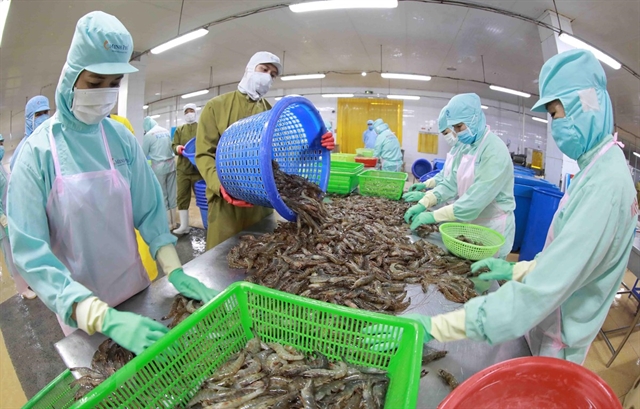 Economy
Economy


|
| Shrimp processed for export. — VNA/VNS Photo Vũ Sinh |
HÀ NỘI — Exports of seafood products saw their best month in May since the beginning of this year, a positive signal amidst the gloomy outlook of global demand.
The latest updates from the Việt Nam Association of Seafood Exporters and Producers (VASEP) showed that seafood exports reached more than US$808 million last month.
That said, total seafood exports for 2023 saw a 29 per cent drop over the same period last year, estimated at around $3.37 billion. Exporters saw the number of orders drop by 20-50 per cent.
Major products saw significant drops in exports, for example, tra fish by 40 per cent, shrimp by 34 per cent and tuna by 31 per cent.
Exports to the US fell by 48 per cent, the EU by 33 per cent, China by 25 per cent, Korea by 21 per cent and Japan by 8 per cent.
VASEP said that seafood exports were struggling due to falling global consumer demand and growing competition with other countries like Ecuador and India.
The resilience of farmers and seafood enterprises weakened on rising production costs, slower consumption and increasing inventory, as well as capital exhaustion and difficulties in accessing credit, they said.
VASEP warned about a potential shortage of raw materials at the beginning of 2024 when the market is expected to recover. Businesses might be exhausted by this point. “The situation is even more difficult than the peak of the COVID-19 pandemic,” the association said.
Although seafood exports saw improvement in May, the global market demand has not seen positive signals overall, the association said, adding that there is a very low chance the market will fully recover before the end of this year.
VASEP predicted that seafood exports this year will likely reach just US$9 billion, about US$2 billion lower than last year.
In the US and the EU, problems abound regardless of positive signals in the economy and stabilising inflation - notably with regard to existing stockpiles of seafood products. These markets imported massively in 2022 and then encountered an inflation shock, which pushed up inventories while pushing down prices.
The whirlwind of cheap products from Ecuador and India also overwhelmed Vietnamese products in these markets.
In the short term, seafood exports to these markets will remain difficult, the association said.
Exports to Japan and South Korea also dropped on inflation pressure but did not see dramatic falls like in the US and the EU. Firms are optimistic about these markets, noting that if inflation slows, exports will recover rapidly.
VASEP said the biggest problem facing firms is high input costs alongside low selling prices. If farmers and firms abandoned ponds, the consequences would be serious, the association said. When the market recovers, there will be no materials for processing and Việt Nam might lose its position to other countries.
“It is pressing to lower interest rates to unlock the capital flows for production and business,” Vasep said. The lending rates for loans in US dollars should be reduced to below 4 per cent and 7 per cent for Vietnamese đồng to support exporters.
From the third quarter of 2022, the lending rates for loans in US dollars increased from lows of 2.2 per cent to highs of 4.9 per cent.
A special credit package with reasonable rates should be raised for farmers who are facing difficulties in accessing credit to encourage them to maintain production instead of abandoning their ponds.
The association also called for the launch of a package worth VNĐ10 billion for producers and exporters in Mekong River Delta to buy raw materials for reserves. —VNS




